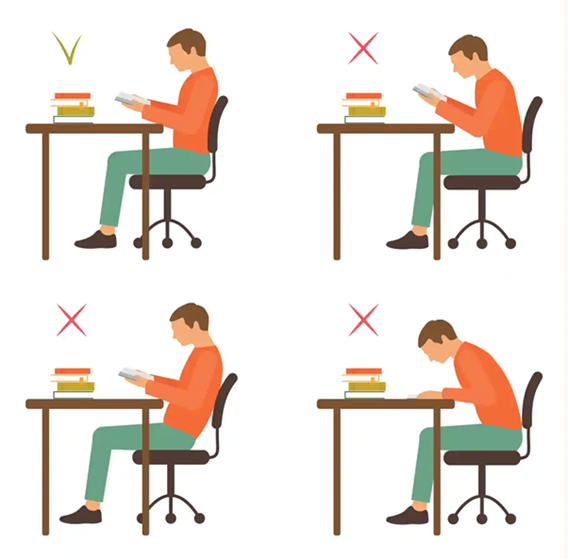Originally posted on August 20, 2022 @ 2:45 PM
Myths are easily maintained when accompanied by symbols. The merging of symbol and myth creates a new truth, symbolic truth. Such truth is not real or true, but is made symbolically true.
We see this all the time in the safety industry with simple constructs like the Swiss Cheese (Reason) or domino theory (Heinrich). Neither are real or true but are made symbolically/mythically true to maintain the myth of linear causality. There is no linear causality.
Safety maintains many of its symbolic myths due to an ignorance of semiotics. There is no study of semiotics globally in any safety qualification.
Recent research shows that safety myths associated with posture are not true.
Yet, you will find this mythology in any ergonomics or safety text. ‘Officewise, A Guide to Health and Safety in the Office’ by Worksafe Victoria is a good example.
When a myth is accompanied by graphics of people in so called ‘right posture’ it seems like a truth is being stated, regardless of the fact that it has no empirical or research support.
Typically, in such texts we see graphics as in Figure One. Right Posture.
Figure One. Right Posture
The reality is, most of these semiotics have more in common with old behaviourist folk lore.
Most traditional Ergonomics texts are full of this stuff without any regard for Holistic Ergonomics, human phenomenology or the neurocognitive nature of affordances. For more read anything by Damasio, Johnson, Fuchs or Lakoff. Similarly, the brain-centrism and behaviourism of these texts is never questioned. Such is the myth of compliance and the sin of critical thinking in safety.
Typically, texts like ‘Fitting the task to the Human, A Textbook of Occupational Ergonomics’ is completely silent on anything to do with Socialitie, embodiment, motor sensate being, affordance or the many realities of cognitive neuro-scientific research.
The mechanistic and behaviourist assumptions of such texts are served by self-endorsed arguments that imagine humans as machines. Most of the time the opposite is the case, the real agenda is fitting the human to the task!
We learn in this latest research by O’Sullivan, Straker and Saracen that good posture doesn’t prevent back pain neither does bad posture cause back pain.
What the research shows is that many social psychological and holistic factors are critical to the prevention or development of back pain and other musculoskeletal problems.
How strange that such things as: diet, exercise, mindset, social engagement, good sleep, meaning and purpose are more essential to the prevention of back pain. Such is the mythology of safety.
We discuss safety myths about ergonomics and much more in our module on Holistic Ergonomics soon to be presented in Workshops in Perth on 3-7 October (https://safetyrisk.net/due-diligence-and-holistic-ergonomics-workshops/).
The same week in Perth offers the outstanding workshop on Due Diligence with Greg Smith and Dr Long presenting together. This powerful workshop also blows away the many safety myths about the law that plague the safety industry. You can see Dr Long and Greg Smith in action here: https://vimeo.com/showcase/3938199
Now with over 100,000 downloads this powerful series and free book download (https://www.humandymensions.com/product/risky-conversations/) really empowers people to better understand the realities of the courts and how safety regulations should be legally understood, well beyond all safety mythology. You can also purchase Greg Smith’s best seller Papersafe here: https://www.booktopia.com.au/paper-safe-gregory-w-smith/book/9780987630001.html
Holistic Ergonomics and the Due Diligence modules reject the behaviourist notion that humans are like machines, the brain is a computer that guides the machine and that the courts exercise justice. Such assumptions are completely erroneous and direct the industry away from helping persons better manage risk.
Holistic Ergonomics and Due Diligence consider the whole person in understanding risk.
12. HIGH-VIS from Human Dymensions on Vimeo.




Linda McKendry says
Love it when the TRUTH is shared about things like this. As a retail design consultant, I’ve always looked for ways to use ergonomics to make humans feel more comfortable and in a happy environment, while also being safe. I often have to comply with building codes that each year get more excessive and difficult for small retailers to encorporate in their builds. I understand that there are “special needs” people. In one case we deliberately removed seating for the comfort of the customers in an ice cream shop in order to avoid having to design two washrooms and have less room for the product service. We had to choose and in my opinion customers with strollers and small children need a place to sit down, even just a bench with no table. Then the process to have a variance is so complicated and time consuming, it isn’t worth it… to try. Why is there no logic or common sense? As you are pointing out, some things go beyond ‘reality’ ! ( yes, I guess I’m ranting!) LOL
Rob Long says
Thanks Linda. In SPoR we study Holistic Ergonomics, where we take seriously the whole person. Not just in some slogan but in validating ways of knowing way beyond safety. In such a Transdisciplinary view we know that an ethic of personhood is foundational to address many ergonomic issues.
I don’t know if you have read about ‘Sick Building Syndrome’ (Murphy) but when we prioritise Technique (Ellul) (efficiency) over persons in what we design, we most often demonsise persons and create illness.
You won’t read about this anywhere in safety because it is consumed with engineering and behaviourism. Indeed, when Safety talks about safety in design, its focus is on the object NOT the person and certainly not holistically.
We also see this in the way Safety defines culture by omitting many critical aspects of personhood in any consideration of how design creates affordance. In a similar way safety puts such important matters like emotions and the unconscious in the ‘too hard basket’ thereby enabling the creating of toxicity in workplaces.